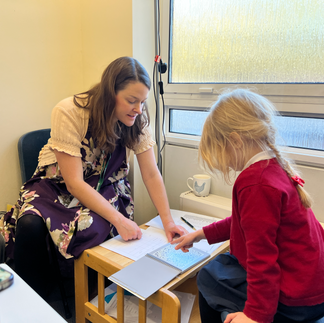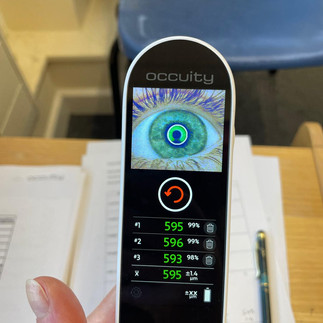How does the Occuity PM1 Pachymeter compare with a desktop-based biometer with 4-11 year-olds?
- Dr. Emily J Patterson

- Dec 6, 2024
- 4 min read
The joy of unboxing a new toy isn’t just for children — sometimes, it’s for researchers too!
This time, the toy in question was the Occuity PM1 Pachymeter, and I couldn’t wait to try it out on my young volunteers. Over two weeks, I had the privilege of working with children at a local primary school in Crowthorne as part of my UKRI-funded Mynamics project: Dynamics of Childhood Eye Growth (DoCEG).

Over the next five years (and possibly longer), the DoCEG project aims to unravel how the structures within the eye grow in relation to one another during childhood. By tracking these changes, we hope to identify key risk factors that predict the onset and progression of myopia (short-sightedness) and lead to earlier interventions that preserve vision.
In the Field: Testing with Young Volunteers
I must admit, I was a little apprehensive at first. How many children would sign up? Would they be cooperative? To my delight, the turnout was fantastic! Over ten days, my colleague, Ashlesha Mahadar, and I tested 159 children (318 eyes) across seven classes, aged between four and 11 years.
During these sessions, we measured:
Height and weight
Colour vision
Corneal thickness, using the PM1 Pachymeter (Occuity)
Ocular biometric measurements, such as axial length and corneal curvature, using the Lenstar (Haag-Streit)
What stood out most was how inquisitive and cooperative the children were. Their curiosity was contagious, and I was thrilled to achieve a 100% success rate with the PM1 Pachymeter—a testament to both the children’s engagement and the device’s user-friendliness.
The first phase of data collection couldn’t have gone better. From the measurements we gathered, we’ll gain insights into how the eye’s structure develops during these formative years. I’m especially excited to analyse the results and share them with the children, their parents, and their teachers.
The children’s enthusiasm made the experience even more rewarding. Many were fascinated by the technology, asking questions and eager to see their own eyes reflected in the PM1. Their positive attitude reassured me that we’re on the right path to making this study both impactful and enjoyable for everyone involved.
Looking Ahead: Exciting Next Steps
This is just the beginning. In six months, I’ll revisit the school to collect additional data. This next phase will include photoreceptor metrics, captured using an adaptive optics fundus camera (Imagine Eyes rtx1), and refraction measurements, taken with an autorefractor (Nidek Handy-Ref).
Each step brings us closer to a comprehensive understanding of childhood eye development. With each visit, I hope to continue building strong connections with the children and their school community.
Advantages of the PM1: A Game-Changer for Paediatric Testing
Unparalleled Portability
The PM1’s handheld, portable design is a well-advertised feature, and it’s easy to see why. Transporting and storing the device is a breeze, but the real surprise came from how much its mobility simplified testing children.
Alignment Made Easy: The children’s heights ranged from approximately 50 to 160 cm. Aligning them with the desktop biometer often required a combination of a height-adjustable desk, chairs with or without pillows, or even standing on steps of varying heights. This process was time-consuming and often required multiple attempts before achieving the proper alignment. In contrast, the PM1 eliminated this hassle—children simply sat in a regular chair, I held the device up to their eye, and we were ready to go.
Handling Movement: Sitting still doesn’t come naturally to many children, and I initially assumed that the desktop device’s head- and chin-rests would help. How naïve! A child who doesn’t want to stay still simply won’t – making the PM1’s adaptability invaluable. With its handheld design, I could follow the child’s movements rather than forcing them to remain stationary, making the process quicker and less stressful.
Seamless Refocusing
The desktop biometer required multiple steps to adjust focus. First, the operator needed to set a coarse focus by pressing a button and then fine-tune it. If a child moved significantly, the entire process had to be reset from the beginning. In contrast, the PM1 automatically adjusted as needed. If the child moved, I simply realigned the device, and it continued the measurement without interruption.
Improved Visibility
The PM1’s slim profile had a significant advantage. The bulkier desktop device often blocked the view of the child, making it difficult to identify why a measurement wasn’t working. Were they tilting their head? Looking the wrong way? Getting distracted? Troubleshooting often meant starting over. With the PM1, I could maintain a clear line of sight, allowing me to spot and resolve issues immediately, saving time and improving the overall experience.
Tips for Using the PM1 with Children
Working with young children requires creativity and adaptability. Here are a few tips that helped us get the most out of the PM1 during our testing sessions:
Managing Backward Movement: Some children had a tendency to lean backward during alignment. If you have access to a high-back examiner’s chair, asking the child to rest their head against it can be helpful. In our case, we used a pillow placed behind their head to provide gentle support.
Familiarising Children with the Device: The PM1 emits a low buzzing sound and a slight vibration when taking measurements. To prepare the children for what to expect, I demonstrated this before starting the test, turning it on and letting them observe the buzzing firsthand.
Encouraging Focus: Not all children intuitively understood where to look. I told them to focus on the “horseshoe shape” inside the device. For those who struggled, I adapted my instructions: I might challenge them to find their own eye in the reflection, which worked well for more curious or easily distracted children. Alternatively, I directed their attention to visible elements on the device, such as the button or logo, to keep their gaze steady.
Mynamics! Intrigued? Want to find out more? Please take a look at the website.













Comments